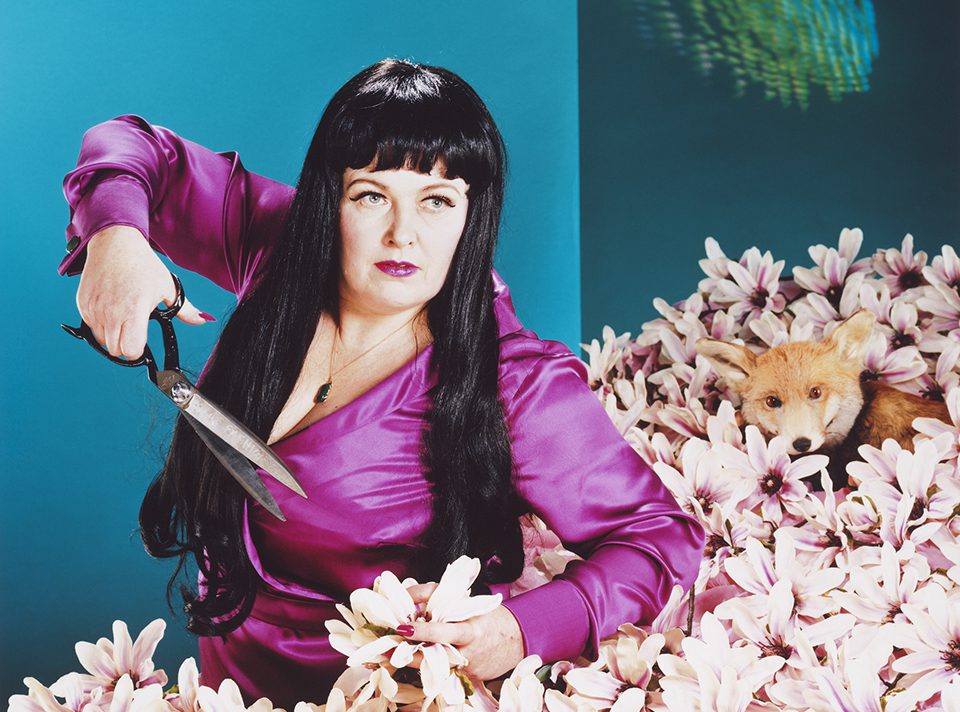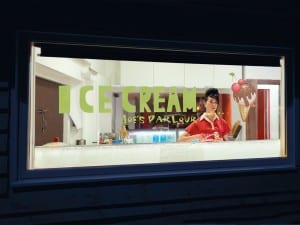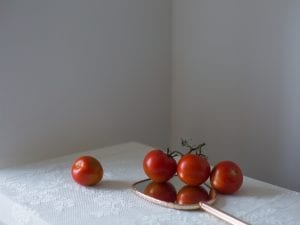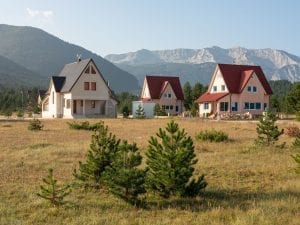In autumn 2010 at the Purdy Hicks Gallery, Neeta Madahar explored the natural and the contrived by subverting the airbrushed and the false.
Neeta Madahar (b. 1966) has created a stir in the world of photography since her first major show in 2004. After studying at Winchester School of Art, and The School of the Museum of Fine Arts and Tufts University in Boston, her work has been exhibited extensively in Europe and the USA. Her recent images have been concerned with nature: images of birds feeding (Sustenance, 2003), seeds floating gently down from the sky (Falling, 2005), or flowers strewn across a picture like a constellation of stars (Cosmoses, 2005-2007). Each series was a gentle evocation of the beauty in the mundane, or photographic meditations on common yet unseen wonders, with a sensitivity to colour that emphasised the fleeting delicacy of the subjects.
Madahar’s latest exhibition, Flora, continues her interest in flowers, but only as props for the subjects who are female friends of the artist. All the supposedly “natural” elements in these new images are extremely contrived and used as backdrops in lush portraits that resemble classic mid-20th century Hollywood glamour shots. This change of direction in her work is as jarring as if fiercely naturalistic photographers such as, William Egglestone, Nan Goldin and Wolfgang Tillmans had all suddenly decided that their muses were henceforth going to be Horst P. Horst, Angus McBean and Madame Yevonde. The women are aged in their 30s, 40s and 50s, and although carefully dressed and posed, with no efforts spared regarding lighting, clothing, and general props, they are left as “natural” looking as possible. This means there have been no attempts to disguise their age or tamper with their looks: no airbrushing, soft focus or Photoshop. So amid the carefully contrived settings, vibrant colour and luxury fabrics, these subjects are sometimes awkwardly posed, with “flesh that creases, crumples and overfills [with] knowing, ‘lived-in’ facial expressions.” The contrast between the idealised, artificial, front-page glamour of Hollywood and inconvenient biological reality could not be better articulated. The artist emphatically states: “There has been no digital retouching of the images. With this series I felt that I needed to delineate my relationship to photographic ‘truth’ and I chose to stay within the confines of what is feasible following a non-digital process. I wanted to see what regular, mature women look like and how skin, muscle and fat appears when restricting oneself to the benefits of hair and make-up products, the flattery of clothes, controlled studio lighting and the image manipulations, such as dodging and burning, that can be executed in an analogue darkroom.”
But there is more to these pictures than merely another artist railing against the oppressive fashion industry. Whilst it remains true that the mass media images of women contribute to an impossible ideal that triggers an acute sense of failure in so many of its subjects, Madahar is orchestrating something more complex than an elegantly artistic slagging-off of this glossy behemoth. Citing influences such as Cecil Beaton, George Hurrell, Horst P. Horst and Angus McBean, Madahar examined the highly constructed nature of their portraits, along with the apparent readiness of their subjects to collude in the role play necessary to make the images work, leaving a mark on her work. She says: “I’m attracted to the high level of construction and theatricality present in the work of these photographers. Another common strand is the pleasure in materials, textures and shaping of light. For example, many of Beaton’s images contain sparkling, shimmering surfaces that are so bright they caused areas of his photographs to become blown out. The exaggerated, excessive flamboyance evident in the portraits of many of these photographers is also something I embraced in Flora.”
And yes, Madame Yevonde is also quoted as an influence, particularly her iconic Goddesses series made in 1935. Admiring the surrealism of Yevonde’s portraits, Madahar acknowledged that they were a point of departure for the Flora series. She agrees that her work explores extreme, stylised femininity and more fantastic associations with female beauty; however, central to the project is her rejection of conventional fashion models. But also, and perhaps more importantly, is her collaborative approach to making these portraits. She shares history, as well as degrees of intimacy and trust, with the subjects of Flora, and the whole series is an exploration of how such friendships can manifest in photographic portraiture. These images are a conscious attempt to counter notions of what are currently deemed “acceptable” portrayals of women, but Madahar adamantly stresses that her subjects decide how they will be shown: “My interest in the fantasy, feminine projections that constitute Flora was to see what kind of images could be made in the present day, when an aging female photographer and sitter that share a friendship – inherently entailing some history, intimacy and trust – collaborate on an equal, non-hierarchical footing. Our awareness of gender, identity politics and how the vast array of images that are in circulation, portraying idealisations of women, operate on our subconscious was embedded in the process of making the work. Flora has given me greater insight into perceptions of beauty amongst my peers and how these impact upon self-esteem and confidence. Given the regular frequency with which articles about beauty, aging and sexuality appear in the media, I am also increasingly angry at the blatant way the visibility and career trajectories of women are thwarted by current prejudices.” The sitters were involved in creating the overall image by selecting the flowers and suggesting themes or emotions, such as melancholy or innocence. Each sitter participated by deciding the tone and including an object that was personal to them, introducing their personalities into the photo.
Being acutely aware of how photographic images of women are used, Madahar is naturally conscious that female portraits automatically enter into a dialogue with general fashion and beauty photography and also, therefore, with issues about digital retouching. With this in mind, and as already stated, she has restricted all the visual enhancements in Flora to make-up, lighting and general darkroom printing processes. Highly detailed aspects of each picture are the result of using a large format view camera and despite looking casually assembled, each aspect – hairstyle, make-up, pose, props and technical process – was very carefully considered. Madahar knows all about the power of colour and admits that producing “luscious, colour-saturated prints is a deliberate means of inviting viewers into a closer scrutiny of the works.” Her regard for colour, its influences, and what it means in her work, signifies that Madahar is a perfectionist: “I don’t have any fixed tools or tricks, other than that I tend to shoot with Kodak Portra VC (vivid colour) film. Each body of work throws up its own unique considerations, including how colour will be used to manifest the final work. Although I understand the application of colour fundamentals, like the relationship of complementary colours, I largely use colour intuitively for the sensations it evokes in me rather than from a rational, objective standpoint. David Batchelor’s book, Chromophobia has been an important reference point in relation to colour. The descriptions associating colour with the irrational, the emotional and the feminine along with the idea that colour represents a fall from grace appeal to me. In terms of a more formal influence, I’m sure the abundance of sensory stimulation from flowers, incense, fruit and the colours of saris that I have experienced at religious ceremonies and functions like Indian weddings have left their mark.”
Comparisons with classic Hollywood glamour are quite apt, but the Flora series manages to feel contemporary, which is no doubt due to its acknowledgement of current “glamour” photography and advertising. Drama, contrived composition and staging, along with heightened colour all result in images that easily command the viewer’s attention. But there is something more at play here, and this extra something vindicates Madahar’s methods. However, she may have used her subjects, the collaborative approach has enabled them to emerge as credible, powerful women who are surprisingly more attractive despite not conforming absolutely to the airbrushed ideal. The often-flimsy props, overtly contrived drama and saturated colour all heighten the focus on the subject, ensuring the women are more commanding and therefore more effortlessly compelling. Although the camera, as the old adage goes, “never lies”, the photographer can certainly spin, and the skill of the photographer in orchestrating the visual elements of his or her work can be extremely effective.
Madahar creates a marriage of the natural and artificial in her work with such apparently deft ability that one subverts the other: whilst the women in Flora emerge naturally, despite the huge efforts made to contrive their postures, the flowers used start to appear as elaborate, fake adornments. In an earlier series, Cosmoses (2005 – 2007), the flowers were artfully scattered, but were all artificial and made by the artist, but this fact is one of the last to emerge when considering the colour, composition and overall impact of the images: their artificiality effectively disappears. The power of manipulating perception in such a way is a sure sign of an accomplished visual artist at work, and whilst Madahar does not consciously accept this power, she is sharply aware of her role in the manipulation of visual clues. “I don’t think of myself as enjoying some kind of power to marry the natural with the artificial, although clearly I am interested in the construction of images rather than purely documenting what I have found without intervention. The blurred boundaries between nature and artifice and how the interaction of the two is interpreted through perception fascinate me.”
Such a statement is a key to reading another earlier series, Sustenance (2003). Photographed over a period of time, each image appears to be an arbitrary snap of natural garden vegetation, often focussing on birds feeding. These pictures appear so casual and “instant” that they immediately bring to mind the current fashionable master of the understated mundane, Wolfgang Tillmans. Like Tillmans, Madahar senses the natural way that photography allows a “magnification of the mundane” purely by making whatever is framed worthy of selection and therefore aesthetically valid. In the hands of a skilled photographer, these captured, usually unnoticed glimpses can assume a powerful resonance. Intense scrutiny of the casual, frozen moment is why, Madahar admits: “I get so much satisfaction and pleasure working with photography.” Not surprisingly, she cites the influence of two modern American photographic masters: William Eggleston and Larry Sultan. “Eggleston’s colour images were a pivotal inspiration before I’d even picked up a camera to start photographing and in the early stages of absorbing everything I could about photography, Larry Sultan’s book, Pictures from Home was a major influence as he told the story about his parents’ lives through the interweaving of documentary and staged images.”
Passionate about art as a child, Madahar was discouraged from pursuing it by her parents because it wasn’t a subject they considered serious or one that would help her support herself. In her mid-20s she started doing a weekly painting and drawing evening class, which fired her enthusiasm for art again and made her determined to pursue life as an artist: “My use of photography came after I had worked in painting, drawing, installation and video. I love the elegance, problem-solving logic and language of mathematics, but my route to photography came through the exploration of fine art. There are a wide range of artists that influence me including Tacita Dean, Ed Ruscha and Fischli/Weiss. The art I love makes me lose my breath. I never tire of experiencing it and of course, wish that I had made it first.”
Currently very busy organising exhibitions, Madahar also has a few ongoing projects in development, including a collaborative animation, some self-portraiture and possibly a drawing project that will explore aspects of her Hindu background. Were she to move between the two spheres of art and commercial photography, it could be an exciting way forward, given her methods of working in Flora. Freely admitting she would have no problem exploring areas like advertising if the circumstances were right and her curiosity sufficiently engaged, this could bring Neeta Madahar to her biggest audience yet and establish her as one of our foremost photographers.
Neeta Madahar: Flora ran from 13 October-11 November 2010. www.purdyhicks.com.
David Gleeson





